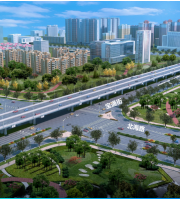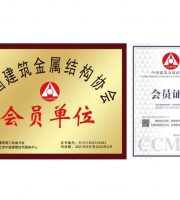This method is fully used in the fabrication and installation of the roof main arch of Nanjing International Exhibition Center in China“ The “unit installation method” is to reasonably block the structure, and then hoist these block units to the design position for installation.
This method requires full support to provide high-altitude shelving and workers’ operation platform.
When multi-point traction is used to realize sliding, in order to avoid torsion of the structure in the sliding process, the synchronization of traction must be controlled.
With this installation technology, the assembly site and mechanical equipment for assembly can be concentrated in a relatively fixed site.
Especially in recent years, most projects have unique architectural shapes, which brings many difficulties to construction, especially installation.
The key consideration of the structural sliding method is that it is difficult to construct the structure directly at the design position.
Compared with the high-altitude in-situ installation method, although the construction method is also installed near the high-altitude in-situ installation, there are few construction measures and simple construction process (no unloading) because there is no temporary support mechanism.
For space truss and reticulated shell structure, block or strip scheme can generally be adopted; 4.
For long-span steel structure buildings, high-altitude in-situ unit installation method, sliding installation method, integral lifting method and long-span cantilever unsupported installation method are several typical and common construction methods, but their applicable conditions and key technical points must be grasped and reasonably selected in engineering practice.
With this construction method, the cantilever section will deflect under the influence of self weight.
The unit must be self-contained and have sufficient stability, stiffness and strength.
It is the highest level of construction technology to deeply understand the structural composition of these projects, understand their load transfer path, be familiar with the surrounding environmental conditions of the project area and the specific requirements of the project, as well as the available construction resources and the proprietary technology mastered by the enterprise, and design the most appropriate and new installation scheme according to local conditions..
It is worth noting that, in addition to the conventional straight-line translation, curve slip is also common in both structural slip and support slip methods, and is frequently used in engineering practice.
The basic idea of structural sliding method is to assemble the whole (or part) of the structure in the site with assembly conditions, and then use the sliding system to move the whole structure to the design position.
This is repeated and accumulated one by one until each unit is pushed to the design position.
To sum up, because this method needs to occupy the site in the structure span, when it is difficult to provide the structure splicing site in the surrounding environment, the support sliding method can be used as one of the solutions.
Scope of application: it is mostly used in large-span structures such as grid structures and reticulated shells with small span and tight construction period requirements.
In general, in the installation methods of long-span and spatial steel structures, when the temporary support cannot be set or the conditions for using the installation crane are poor, that is, there are problems in the direct construction at the building position, the structural sliding method can be used as one of the solutions.
Cumulative sliding: that is, the sliding unit only slides for a section on the sliding rail (not moved to the design position temporarily), and then slides for a distance after the next unit is connected.
The key point of this method is the reasonable division of hoisting units.
Before the sliding element is finally fixed, there is a trend of “easy sliding” in the moving direction and its orthogonal direction of the structure, because different from the design support conditions, in order to prevent the deformation outside the design (i.e.
For beam column structure, it is generally recommended to set the section position at the reverse bending point in the design; 3.
outside the sliding plane), it is necessary to take measures to prevent “sliding”, such as setting self-balanced rigid pull rods or flexible cables near the supports on both sides.
The so-called “bulk method” generally refers to a method of directly assembling components at the design position by cantilever method or full support method.
2、 The integral lifting installation method and sliding installation method can be divided into two types: structural sliding method and support sliding method.
For example, the construction site around the site is limited and the normal walking of hoisting equipment cannot be met in the span.
Generally, the following points should be grasped: 1.
In this way, conditions are created for the in-situ installation of adjacent structures, and such cycle is carried out until the overall installation of the structure is completed.
Therefore, different from the structural sliding method, the support sliding method can be summarized as “the structure does not slide and the support mechanism slides”, and the structural sliding law is “the structure slides and the support mechanism does not slide”.
The basic elements of this construction method only replace the ground assembly, reaction support and overall lifting in the “overall lifting construction method” with “lateral movement”, so it is essentially the same as the lifting construction method.
The “unit installation method” has been adopted in Guangzhou Opera House, the main stadium of Shenzhen Universiade and Shenzhen Bay Sports Center.
When the height of long-span steel structure is high, which is not conducive to the erection of supporting jig frame and the shape of lifting steel structure is regular, the construction method of overall lifting can be used as one of the options.
The construction characteristics of the two methods are introduced below.
For example, for long-span steel truss structure, the block position should not be in the middle of the truss span; 2.
It is suitable for cantilever steel structures with large rigidity, good stability and high height.
In addition, the structural sliding method also includes two different processes: frame by frame sliding and cumulative sliding.
At least several points should be paid attention to when using this method: 1.
The sliding element shall be a geometrically invariant system with sufficient stiffness and stability during sliding to reduce the resistance during sliding as much as possible.
4.
After the installation of this part of the structure is completed, the support slip is separated from the installed structure.
3.
Disadvantages: the support erection time is long, there are many high-altitude operations, the construction period span is large, and a large number of support materials are required, occupying a large number of sites in buildings.
When the support sliding method is adopted, the design of the support frame should not only meet the conventional overall and local stability, but also consider the horizontal dynamic load (horizontal inertia force caused by startup and braking), If necessary, large diagonal bracing can be added to improve its lateral stiffness.
Compared with the in-situ installation method, it can reduce the amount of measures for temporary support and operation platform, and save the cost of site treatment and management.
Sliding one by one: slide one or several sliding elements from one end to the design position, and each sliding element is connected at high altitude to directly form the overall structure.
The trouble caused by this is that the installation coordinates of the components are unknown.
3、 Integral lifting installation method integral lifting installation method integral lifting installation method is an installation method that assembles the structure to be installed on the ground or at a suitable floor projection position, and then uses the “lifting system” to lift the formed structure up to the design elevation.
Several common construction methods of long-span steel structure 1、 High altitude in situ unit installation method high altitude in situ unit installation method high altitude in situ installation method includes high altitude in situ bulk method and high altitude in situ unit installation method.
4、 Unsupported installation method of long-span cantilever steel structure unsupported installation method of long-span cantilever steel structure the so-called unsupported installation method of long-span cantilever steel structure is to install high-altitude parts with hoisting machinery based on the stiffness of the cantilever steel structure without supporting mechanism, and carry out construction in the way of gradual extension and stage installation.
The size of the unit depends on the selected crane capacity and structural form.
The longer the sliding route, the higher the efficiency; 2.
If it is difficult to ensure, the impact of asynchronous traction on the sliding unit shall be fully calculated and evaluated, and temporary reinforcement can be carried out for the sliding unit if necessary.
The structural support is conducive to the laying of sliding track.
In order to ensure the smooth splicing of field units, several units should be pre assembled in the factory.
Advantages: due to the light weight of a single piece, the lifting requirements of lifting equipment can be effectively reduced.
Support slip method support slip method is to set up a support frame in the structural design group to provide support and operation platform for the in-situ installation of the structure.
When there are requirements for the installation configuration or closure, the configuration control of the structure in the construction process is one of the biggest technical problems, which is directly related to whether the structural configuration at the completion can meet the requirements and whether the cantilever section can be closed smoothly.


